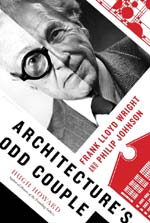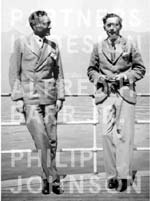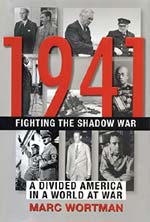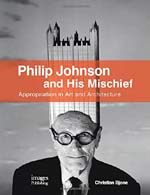
|

|
|
Home Site Search Contact Us Subscribe
|
|
Return of the Broken Pediment A review of three recent books involving the life of Philip Johnson By Christian Bjone July 7, 2016 Architecture's Odd Couple: Frank Lloyd Wright and Philip Johnson By Hugh Howard (Bloomsbury Press, 2016)
Partners in Design: Alfred H. Barr Jr. and Philip Johnson By David A. Hanks (Editor), with Donald Albrecht, Barry Bergdoll, and Juliet Kinchin (The Monacelli Press, 2015)
1941: Fighting the Shadow War: A Divided America in a World at War By Marc Wortman (Atlantic Monthly Press, 2016)
The architect and personality Philip Johnson just refuses to go away. So this year there are three recent publications on various aspects of the great man who died on January 25, 2005. Ten years after his death, I published my own personal attempt to seriously discuss his much maligned Post-modern work in Philip Johnson and His Mischief: Appropriation in Art and Architecture. I thought that I was all alone in my interest, but the flood gates have opened. The difference is that these volumes do not engage his design work and, instead, focus on his outsized character, connection to political events, and the Museum of Modern Art.
The most limited of the three is Architecture’s Odd Couple: Frank Lloyd Wright and Philip Johnson, in which the author Hugh Howard traces the history of the personal involvement between Johnson and Wright (“The Prince comes to visit the King”) as an exploration of the early debate on modern architecture in the U.S. Unfortunately, to this reviewer the use of a TV sitcom name in the title sets up an imagined narrative where Johnson plays a nervous young Felix and Wright plays a cantankerous elderly Oscar. You can see them in your mind on the stage set filming the comedy, including the taped laugh track. The book establishes that the great men bitch and moan until the end, when they make up and hug. I am sorry to say that this is all the depth there is to this quote fest.
The most academic of the trio is Partners in Design: Alfred H. Barr Jr. and Philip Johnson edited David Hanks, which also serves as a catalogue for the traveling exhibition of the same name, curated by Hanks. It all started with the donation by the daughter of Barr, the first director of the Museum of Modern Art (MoMA), of the family’s 1930s chrome furniture to the Montreal Museum of Fine Arts. The book vastly inflates the historic importance of the few Modernist chairs and tables belonging to Barr and Johnson (friends and co-workers at MoMA), shown in the Canadian exhibition. But the chapter by Barry Bergdoll saves the assembly of weak essays by touching on bigger themes of the protagonists’ 1932 MoMA show ”Modern Architecture: International Exhibition.” [Ed. note: The exhibition is on view at the MMFA until August 21, then travels to the Davis Museum in Boston, the Kunsthalle Bielefeld in Germany, and the Grey Art Gallery in New York.]
The wild card in this handful of books is 1941: Fighting the Shadow War: A Divided America in a World at War, a prequel history of America’s involvement in World War II. Historian Marc Wortman uses an original approach to cover this well-trodden ground of invading armies by showing the vast historic events of that year (Defeat of Poland, 1939, Attack on Pearl Harbor, 1941) through the experiences of several individuals. The opening pair is the journalist William Shirer (CBS Radio in Berlin), and Philip Johnson (journalist for the publication Social Justice) sitting in the same German government limo driving them to the cover the front at Warsaw. This is a not very subtle juxtaposition of an outraged good guy and a spoiled rich kid (pro-German?). Johnson stands in for the “Divided America” of the subtitle, along with Charles Lindbergh and others who wanted America to stay neutral in the European war. After progressing through the year, reaching the climax of the U.S. declaration of war, the book concludes with a short summary of the later lives of the participants. The last line for Johnson is ”He managed to stay clear of the court and, after the war, began to design buildings that led to his emergence as one of the most prolific and influential architects of the postwar years.” Wortman neglects to add the later, formal apologies made by Johnson, one on the Charlie Rose Show, over his insanely stupid period of right-wing politics.
Christian Bjone is a New York City-based architect. His third book is Philip Johnson and His Mischief: Appropriation in Art and Architecture (Images Publishing, 2014).
Also by Bjone: Book Review: "Original Copies, Architectural Mimicry in Contemporary China" by Bianca Bosker A must-have for those who wish to see a design phenomenon and trend explained in a clear and concise manner without the pretentious tribal signifiers that so plague academic writers. |
(click on pictures to enlarge)  Architecture's Odd Couple: Frank Lloyd Wright and Philip Johnson, by Hugh Howard  Partners in Design: Alfred H. Barr Jr. and Philip Johnson, by David A. Hanks (Editor), with Donald Albrecht, Barry Bergdoll, and Juliet Kinchin  1941: Fighting the Shadow War: A Divided America in a World at War, by Marc Wortman  Philip Johnson and His Mischief: Appropriation in Art and Architecture, by Christian Bjone |
© 2016 ArchNewsNow.com